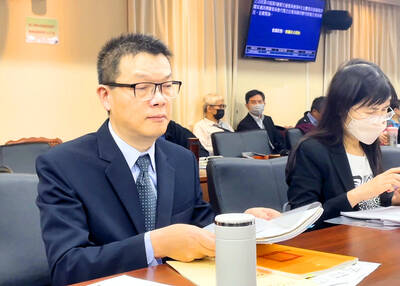China has recently announced its 12th Five-Year Plan for national development. In an interview with Liberty Times (the Taipei Times’ sister newspaper) staff reporter
TT: Could you please analyze China’s 12th Five-Year Plan from a strategic viewpoint?
Chang Jung-feng (張榮豐): The “recommendations” in the Five-Year Plan are assessments of the strategic environment between this year and 2015 and of China’s current strengths and weaknesses.
This includes, first, an assessment on the external environment that states that peace, development and cooperation continue to be the current trends; second, the fact that the effects of the recent financial crisis are still around; third, that global growth is slowing down and that China therefore cannot merely rely on exports to drive its economic growth; fourth, intensifying market, skilled labor, technological and standards competition; and, fifth, the need to pay increasing attention to climate change, energy, resources and food safety.
China perceives its advantages to be, first, that the socialist political system gives China the advantage of being able to concentrate resources quicker in response to crises; second, that China has made strong inroads in terms of industrialization, the increased use of information technology, urbanization, marketization and internationalization; third, that the increase in GDP per capita has given China’s internal demand market much more potential and fourth, that the government’s macro-control abilities have gotten stronger.
China perceives its disadvantages to be first, that further limits need to be put on resources and the environment used in the process of economic development; second, that an imbalance has occurred between investment and consumption; third, that the proportion of resident income to national income is continuously falling; fourth, that China is not strong in terms of technological innovation; fifth, that the structure of China’s industries is not logical; sixth, that the foundations of agriculture are -being -weakened; seventh, that there is a gap in development in urban and rural areas, and eighth, that there are contradictions in overall employment and employment structures.
China has also set three hopes for the future: image, goals and core values.
When China faces a major strategic choice, their core values will become the main criteria for making decisions. These criteria include [former Chinese president] Deng Xiaoping’s (鄧小平) idea that “Development is the indisputable truth” (發展是硬道理), [former Chinese president] Jiang Zemin’s (江澤民) idea of the “Three represents” (三個代表) and [Chinese President] Hu Jintao’s (胡錦濤) “Scientific Development Concept” (科學發展觀).
As far as image is concerned, the first point deals with the image of economic development: The demand side should be driven by investment, consumption and exports, while the supply side should be driven by the agricultural, manufacturing and service sectors. The second point deals with the image of production methods: scientific advancement, a highly skilled work force and innovative management. The third point deals with the image that economic growth is equally shared by all citizens. The fourth point deals with the image of energy savings and environmental friendliness and the fifth point deals with the image of a socio--political system beneficial to technological developments and the equal sharing of opportunity.
Finally, the Five-Year Plan has five fixed goals: steady and faster economic development, strategic adjustments to the economy to encourage greater growth, a more widespread and faster increase in the incomes of rural and urban residents, a noticeable increase in infrastructure and increased reform and opening up.
TT: In concrete terms, what does China’s strategy consist of?
Chang: Although 10 major strategies are listed among the -recommendations and although there are accompanying action plans or concrete measures to each strategy, there is no time factor, which makes it impossible to detect a strategic path. Using abductive reasoning, I have found four important strategic paths leading up to the 12th Five-Year Plan. The key path, or the key strategic path, that we should pay attention to is the path that has been followed for the longest time. This path is key to controlling the timeline for implementing the overall strategy and that is why it is called the key strategic path.
This Five-Year Plan began with the Chinese Communist Party’s policy to speed up reform and perfect the socialist market economy.
The eight main reforms were, first, the creation of different kinds of economic ownership, legally regulating equality in the use of production factors, and fair participation in market competition; second, to deepen the reform of industrial monopolies; third, to perfect various management systems for state-owned assets and create a healthy operational budget and benefit distribution system for state-owned assets; fourth, to support and lead the development of the non-public economy and encouraging non--public enterprises to participate in the reform of state-owned enterprises; fifth, to create healthy land, capital, labor, technology and information factor markets; sixth, to deepen the reform of prices, factors of production and markets for strategic resources — water, energy, mining products, land; seventh, to smooth out the prices for coal, electricity, petroleum, air, water, mining resources; and eighth, to perfect the mechanisms for setting prices for important products, services and factors of production.
When evaluating these reforms, at least a year to two years is needed before we begin to see results.
However, two very important reforms are missing here, namely, the reform of the household registration system and the reform of the market for agricultural land. Due to the progress of the above-mentioned reforms, it is expected that the strategic plan to establish a mechanism aimed at expanding consumption will get under way around next year some time.
It is expected to bring about an increase in the first distribution of national income among urban and rural residents so they will get some pocket money to spend. That can be followed by the strategic strengthening of social construction and establishment of a healthy system for basic public services. The goal is to use government transfer payments to increase the income of urban and rural residents through a second distribution [of national income]. With their increased income, they can increase their consumption without having to worry about the consequences, such as retirement, health insurance and other such issues. There will also be basic guarantees for housing and their children’s education. Through these measures, they will create good consumption prospects, although this goal will probably not be realized until the second half of 2013 some time.
As the public gets money to spend and also dares spend it, the strategy to improve the consumption environment can be used to help increase spending. The increased spending among the public is then matched with the strategies to perfect the structure of foreign trade and to increase the use of foreign investments in order to produce equilibrium in the balance of payments and maintain reasonable investment growth and an optimized investment structure. Finally, these measures will adjust the economic growth model so that consumption, investment and exports work together to drive economic growth instead of the current model where economic growth is only driven by investment and exports.
To sum up, each link along this key strategic path poses a considerable challenge. The greatest challenge is two-fold: the state-owned enterprise monopolies controlled by high cadres and the privileges pertaining to the urban class as a result of the household registration system.
As to the development of seven strategic new industries, cadres at every level are very ambitious, which means that it will not be that difficult to reach the goals, although it will be more difficult to reach environmental, energy savings and technical skill benchmarks.
TT: Does China’s 12th Five-Year Plan mention it’s approach to Taiwan?
Chang: Based on the logic of strategic planning, the goal of the plan’s approach to Taiwan is to further promote the unification of the “motherland.” Since it is only a Five-Year Plan, the goal cannot be to complete the unification of the “motherland.” The core values of China’s approach to Taiwan are to insist on peaceful unification and “one country, two systems,” Jiang’s eight points, Hu’s six points and opposing Taiwanese separatist activities.
In terms of strategic direction, promoting the creation of a mechanism for cross-strait exchanges means to carry out negotiations and sign agreements that can serve as a starting point for its Taiwan-related work within the framework of the 12th Five-Year Plan. That work will then follow three directions, all moving toward the goal of unifying the “motherland.”
The first direction is to promote bilateral investments, let the western coast of the Taiwan Strait function as a test bed, and guarantee the legitimate rights of Taiwanese people as required by law, while strengthening cross-strait cooperation in new industries, the financial industry and other modern service industries in order to create the image that the goals of the Economic Cooperation Framework Agreement [ECFA] are being implemented and that cross-strait economic cooperation is being consolidated. The second direction is to expand exchanges between different sectors and strengthen cooperation in non-economic areas, which is the reason for the calls for a cultural ECFA.
The third direction is to build a framework for peaceful development, which is the reason behind the calls for a peace agreement. These three directions are then joined together in a push for unification of the “motherland.”
TT: President Ma Ying-jeou’s (馬英九) administration keeps talking about peaceful development in its China policies, while the [ideas in China’s] 12th Five-Year Plan has become the new prevailing idea. What are your views on this?
Chang: No one will reject talk about peaceful development, but from a strategic perspective, the main thing is the ultimate goal. It is very clear that while the framework for peaceful development in the 12th Five-Year Plan talks about peace, it is in practice aimed at promoting unification. Some people currently have too high an expectation of a peace agreement, but everyone who has studied game theory understands that the signing of a peace agreement and a promise to turn arms into plow shares will be the first step toward war or surrender.
As far as Taiwan is concerned, the plan will not only bring opportunity, it will also bring threats.
Our problem is that without any thorough analysis of the plan’s strategic directions and without clearly understanding our own industrial strategies or goals, we are creating blind hope and have simply become tools of stock market manipulation. This is the real problem created by the 12th Five-Year Plan becoming the prevailing idea.
TT: Based on your deep knowledge of strategic principles and of the Five-Year Plan, how do you view the Ma administration’s “Golden Decade project (黃金十年計畫),” which it said would soon be revealed?
Chang: China’s Five-Year Plan has basically been developed based on strategic thinking, through 11 stages and studies of more than 160 different topics over about one year and 10 months. Japan’s strategic plan, called “A new growth strategy — a return to Japanese vitality,” was led by former Japanese prime minister Yukio Hatoyama, and it took more than half a year to create that plan.
Some Chinese Taiwan experts have said that based on their own studies of past Taiwanese plans, be it the Asia-Pacific logistic hub plan (亞太營運中心), the Asia-Pacific -capital-raising plan (亞太籌資中心), the six key emerging industries plan (六大新興產業) or the four major knowledge-based industries (四大智慧型產業) plan, have all been mere slogans. I hope Ma’s “Golden Decade project” is a tight strategic plan and not a temporary slogan thought up by a small group of people.

‘DENIAL DEFENSE’: The US would increase its military presence with uncrewed ships, and submarines, while boosting defense in the Indo-Pacific, a Pete Hegseth memo said The US is reorienting its military strategy to focus primarily on deterring a potential Chinese invasion of Taiwan, a memo signed by US Secretary of Defense Pete Hegseth showed. The memo also called on Taiwan to increase its defense spending. The document, known as the “Interim National Defense Strategic Guidance,” was distributed this month and detailed the national defense plans of US President Donald Trump’s administration, an article in the Washington Post said on Saturday. It outlines how the US can prepare for a potential war with China and defend itself from threats in the “near abroad,” including Greenland and the Panama

The High Prosecutors’ Office yesterday withdrew an appeal against the acquittal of a former bank manager 22 years after his death, marking Taiwan’s first instance of prosecutors rendering posthumous justice to a wrongfully convicted defendant. Chu Ching-en (諸慶恩) — formerly a manager at the Taipei branch of BNP Paribas — was in 1999 accused by Weng Mao-chung (翁茂鍾), then-president of Chia Her Industrial Co, of forging a request for a fixed deposit of US$10 million by I-Hwa Industrial Co, a subsidiary of Chia Her, which was used as collateral. Chu was ruled not guilty in the first trial, but was found guilty

A wild live dugong was found in Taiwan for the first time in 88 years, after it was accidentally caught by a fisher’s net on Tuesday in Yilan County’s Fenniaolin (粉鳥林). This is the first sighting of the species in Taiwan since 1937, having already been considered “extinct” in the country and considered as “vulnerable” by the International Union for Conservation of Nature. A fisher surnamed Chen (陳) went to Fenniaolin to collect the fish in his netting, but instead caught a 3m long, 500kg dugong. The fisher released the animal back into the wild, not realizing it was an endangered species at

DEADLOCK: As the commission is unable to forum a quorum to review license renewal applications, the channel operators are not at fault and can air past their license date The National Communications Commission (NCC) yesterday said that the Public Television Service (PTS) and 36 other television and radio broadcasters could continue airing, despite the commission’s inability to meet a quorum to review their license renewal applications. The licenses of PTS and the other channels are set to expire between this month and June. The National Communications Commission Organization Act (國家通訊傳播委員會組織法) stipulates that the commission must meet the mandated quorum of four to hold a valid meeting. The seven-member commission currently has only three commissioners. “We have informed the channel operators of the progress we have made in reviewing their license renewal applications, and